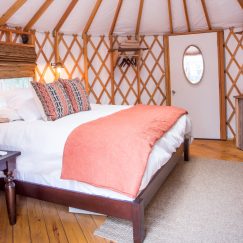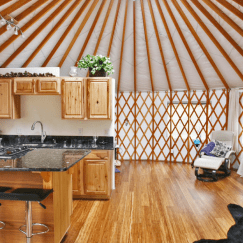5 Types of Tiny Homes
For thousands of years, people have found shelter in tiny houses including yurts. Ancient Greek historian Herodotus of Halicarnassus described the first yurts as appearing between 600 BC and AD 300 in Central Asia. Nomadic herders took refuge in the felt-covered tents on steppes, mountains and in the desert.
Today, tiny houses are in vogue for reasons beyond survival. As folks try to escape the hectic demands of modern-day life, less space helps them to  remember what matters. It’s not about possessions; it’s about appreciating what they have. Some find it easier staying in a space that’s 500 square feet or less, making the small home movement essential.
remember what matters. It’s not about possessions; it’s about appreciating what they have. Some find it easier staying in a space that’s 500 square feet or less, making the small home movement essential.
Finding the best tiny home to retreat to for a vacation or weekend getaway can be challenging. The many options can be overwhelming. We’ve rounded up few types of small homes to consider, so you can make the best choice for you and your family.
1. Shipping Containers
Some of the most visible members of the small home movement make their spaces out of recycled shipping containers.
Thanks to their original industrial use, the steel boxes are extremely durable and resistant to fires and hurricanes. They’re also relatively affordable and fast to build. Canadian engineer Joseph Dupuis built his off-grid tiny home for less than $20,000, for instance.
And with 11 million shipping containers not in use in the world, the move is an environmentally friendly choice. The biggest struggle is probably finding a building permit.
2. Recreational Vehicles
Some call recreational vehicles the original modern tiny home. They emerged shortly after the invention of cars when people began altering them for camping. In 1910, the company Pierce-Arrow released the first RV ever called the Touring Landau. Now, around 10 million households own RVs in the United States.
RV enthusiasts relish the freedom of the open road combined with a cozy place to hunker down at night, as well as vibrant community of fellow RVers. Paying for fuel and maintenance can get spendy, however.
3. Houseboats
Houseboats have drawn people to life on the water for years. Starting in the early-1900s, bohemians and criminals flocked to houseboat colonies in Seattle for their affordability and privacy. The reputations of houseboat devotees have cleaned up since. You can find houseboats in lakes and rivers across the country, and they give visitors an intriguing slice of Americana.
Houseboats aren’t for everyone. They take specialized boating skills to live in and maintain, but they can be liberating and affordable for those who put in the work.
4. Earthships
Nearly half a century ago, architect Michael Reynolds constructed his first off-the-grid home. Fast forward to today, and he’s built and inspired thousands of similar solar homes across the world. He called his designs Earthships because he wanted people to think outside of the conventional definition of “houses.”
With greenhouses that simultaneously grow plants for food and keep the space a balmy 70 degrees year-round without a utility bill, Earthships help people be self-sufficient. Not all Earthships fall under the “tiny home” category, but the ones that do can be a solid choice for those who want to go back to the basics. They do have potential high cost for construction.
5. Yurts
In 1978, Pacific Yurts founder Alan Bair started the company in an old dairy barn, kicking off the modern-yurt industry. The structures have since  popped up in campgrounds, resorts and various other locations worldwide, making them an ideal option for lovers of tiny homes.
popped up in campgrounds, resorts and various other locations worldwide, making them an ideal option for lovers of tiny homes.
Yurts are usually simple to install and may be erected in as little as a few hours. Their frames can last indefinitely if properly maintained, and the yurt can be fitted with features like bathrooms, lofts and kitchens. Those interested in yurts need to check with building codes in their area to see how they’re regulated.
Do you think a yurt could make your tiny home dreams come true? Pacific Yurts remains the leader in the yurt industry today and offers many custom features.

